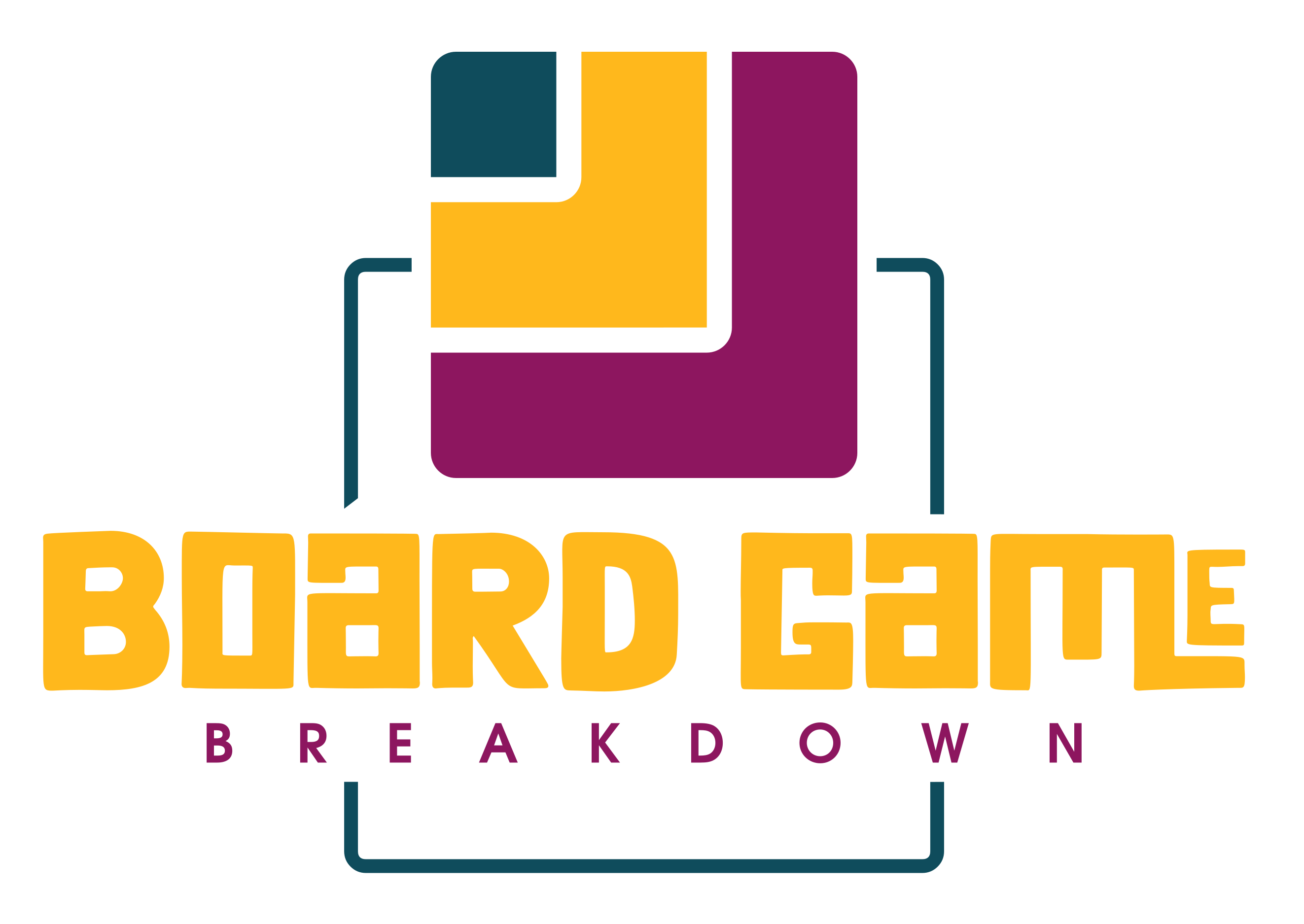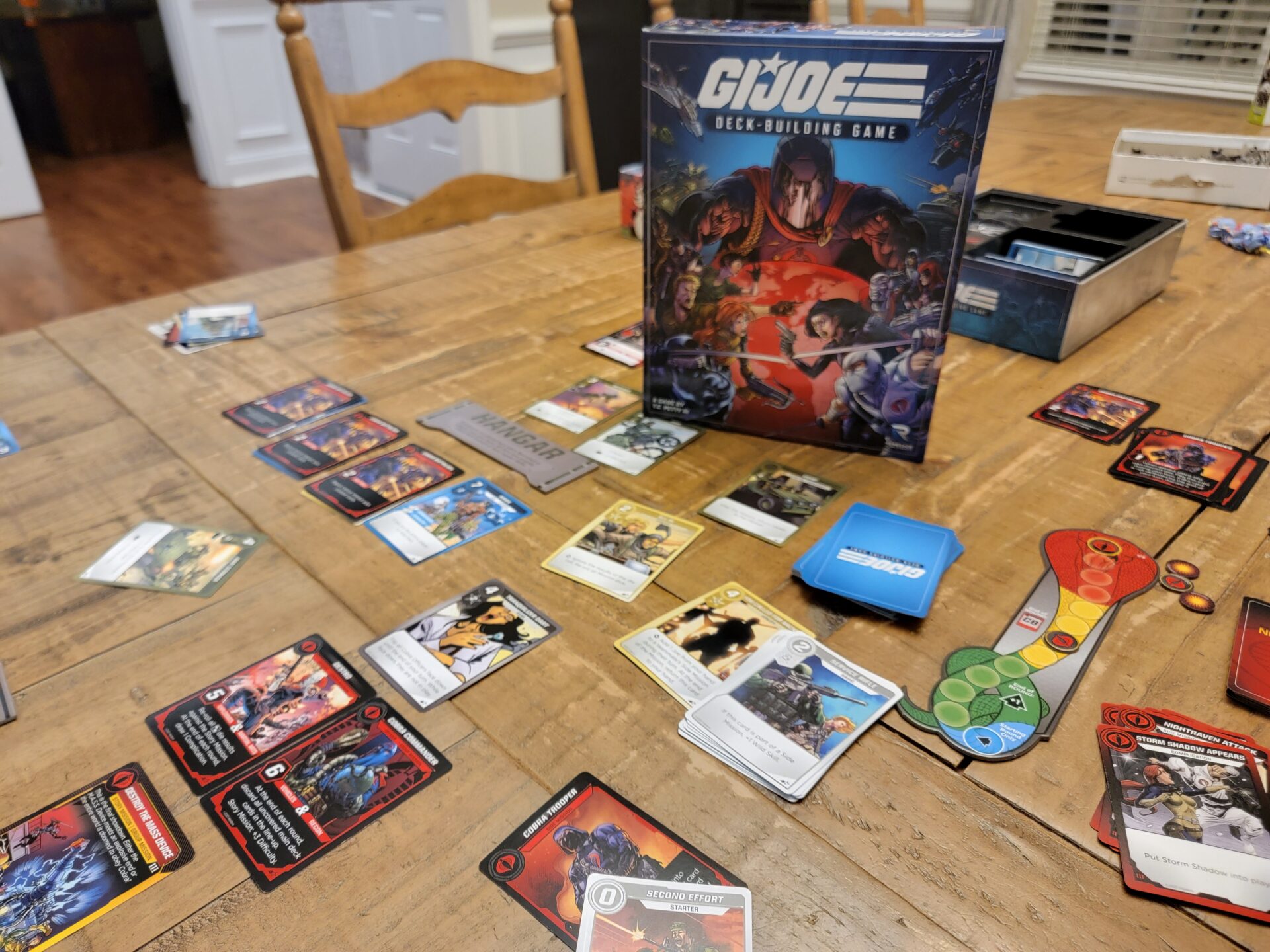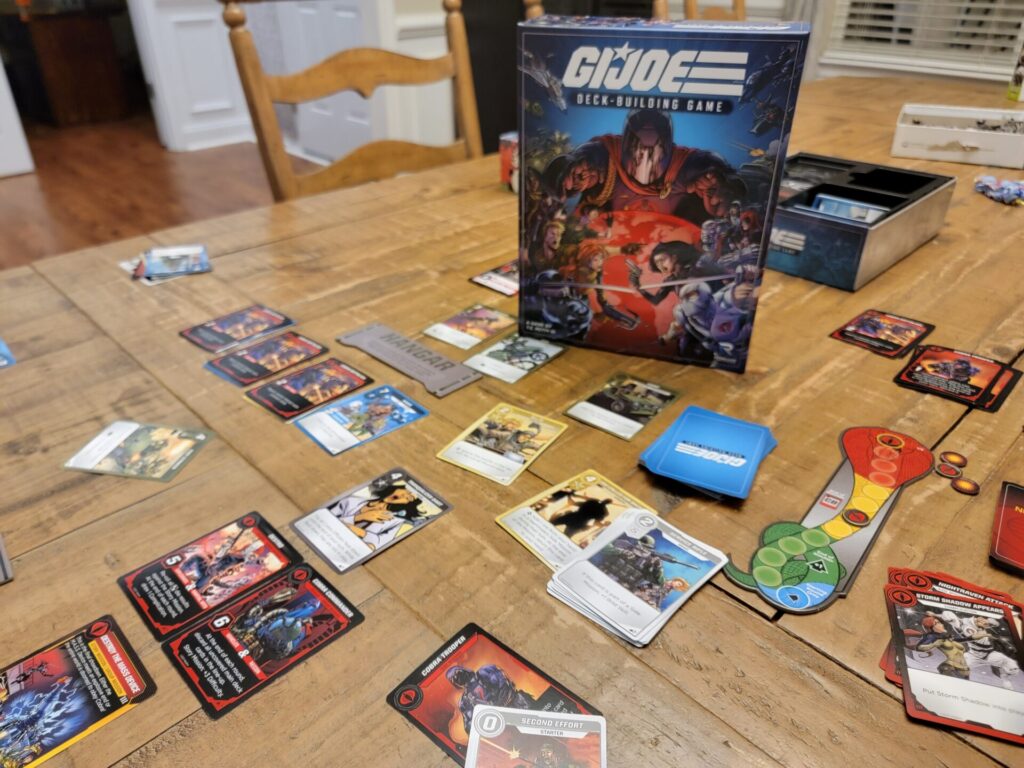
Name: G.I. Joe Deck-Building Game
Year of Release: 2021
Player Count: 1 – 4
Playing Time: 30 – 70 Minutes
Designer: T.C. Petty III
Publisher: Renegade Game Studios
Primary Mechanisms: Cooperative, Deck-Building
Weight (According to BGG.com): 2.76
Overview
It’s a question as old as time: are card games considered board games? Oh, wait… it’s not, you say? Well, even so, the fact that I’m writing a review of a card game on a board game website probably gives away which side of the argument I fall on. As far as I’m concerned, both types of games bring people together using a physical medium, and typically get people’s brains moving, in an academically, creative, or simply, entertaining way. Some of my fondest early board gaming memories were when four of us got together and played Dominion all night long.
Looking over my collection, and games I’ve played, Dominion still stands out as my preferred deck-building game, not counting Living Card Games, as Arkham Horror is by far my favorite. Maybe this is nostalgia speaking, but the fact that Dominion still ranks in the top 200 on BoardGameGeek, 16 years after its release, speaks volumes.
This is the backdrop that is in my head when I picked up the box for G.I. JOE Deck Building Game, at the local gaming store. Also coloring my vision are two facts: 1.) I’ve been seeing this game posted a ton on the Solo Board Gaming Sub-Reddit recently and that piques my interest as I am a solo board gamer around 50% of the time, and 2.) The game store has this last copy on clearance for $19.99. I knew that it was a cooperative game, so it wasn’t going to be exactly like Dominion, but could the fun times I had with that card game so long ago, translate to this new endeavor? Read on to find out!
Rulebook & Components
When writing these articles, it’s a lot easier to get the bad stuff out of the way first. And whoa boy, is this rulebook bad! Sometimes when opening a game for the first time, it’s clear that the way the rulebook is designed, might just not be my cup of tea, but that doesn’t mean it’s bad. It typically still gets the point across, but it might just do it in a manner that doesn’t suit me. I know it’s impossible to be everything to everyone, but this rulebook is not of that aforementioned ilk. It is simply a mess. When someone on BoardGameGeek puts together a file to re-arrange your rulebook so that it makes more sense for the users, you know you’re in for a heaping pile of trouble. If you pick this game up, just go into it with this knowledge and don’t say I didn’t warn you.
Moving onto the components, let’s discuss the plethora of cards you’ll inherit with this game. The cards are split over five primary categories, all of them summing up to a whopping 200+ amount! The players’ hand will be made up of, yep, you guessed it, Player Cards. These cards are made up mostly of JOES, the individual soldiers that will be deploying on missions, but also contain card types such as Utilities, Gear, or Transports. Unlike the overall rulebook, the cards are fairly clear in their intentions and once players understand the overall layout, there won’t be many questions on how the cards interact within the scope of the game. If you’re coming to this game as a long-time fan of G.I. JOE, you’ll definitely appreciate the 80’s style artwork emblazoned on each card.
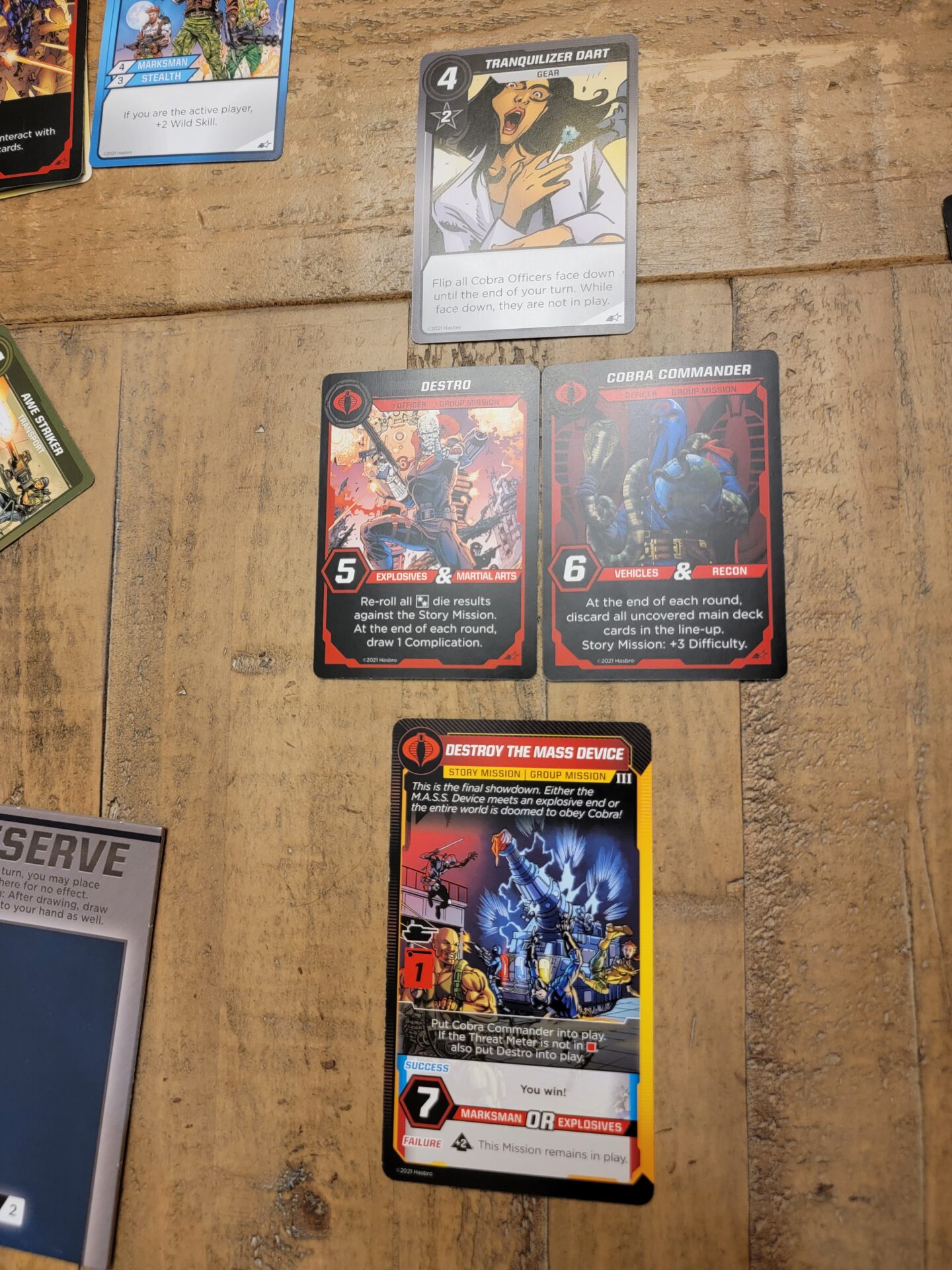
The other card type that really stands out for me are the Mission Cards. The base game comes with two separate missions, each with their own set of cards split into three different Acts. Each Act has a single Finale Card to it and when setting up the game, players will randomly choose three cards of each Act and then sandwich the Finale Cards between the Acts. In this manner, each mission is going to have the same three Finale Cards every time it hits the table, but the balance of the mission might be different from play-to-play. I’ve really enjoyed this system as it gives me a sense of unknown across the majority of the mission while also not keeping me in the dark on everything I will be going up against. This system also allows for great expansion opportunities, allowing players to purchase additional missions to take their JOES on.
Outside of the cards, players will get a few other components within the box. The most used component, outside of the cards of course, is the eight Dice. These are olive drab and six-sided but are marked with Hits and Misses on each side instead of the normal numeric value. If you’ve played any of the entries in the Final Girl series, then you’ll be familiar with how the die are going to be used but if you haven’t, I’ll discuss it more in the Gameplay section below. Players will also get a few tiles, chits, and a Threat Meter, all pretty standard pieces of cardboard that aren’t going to blow anyone away, but this is a deck-building game, so you didn’t come to play with the fiddly cardboard!
Setup & Gameplay
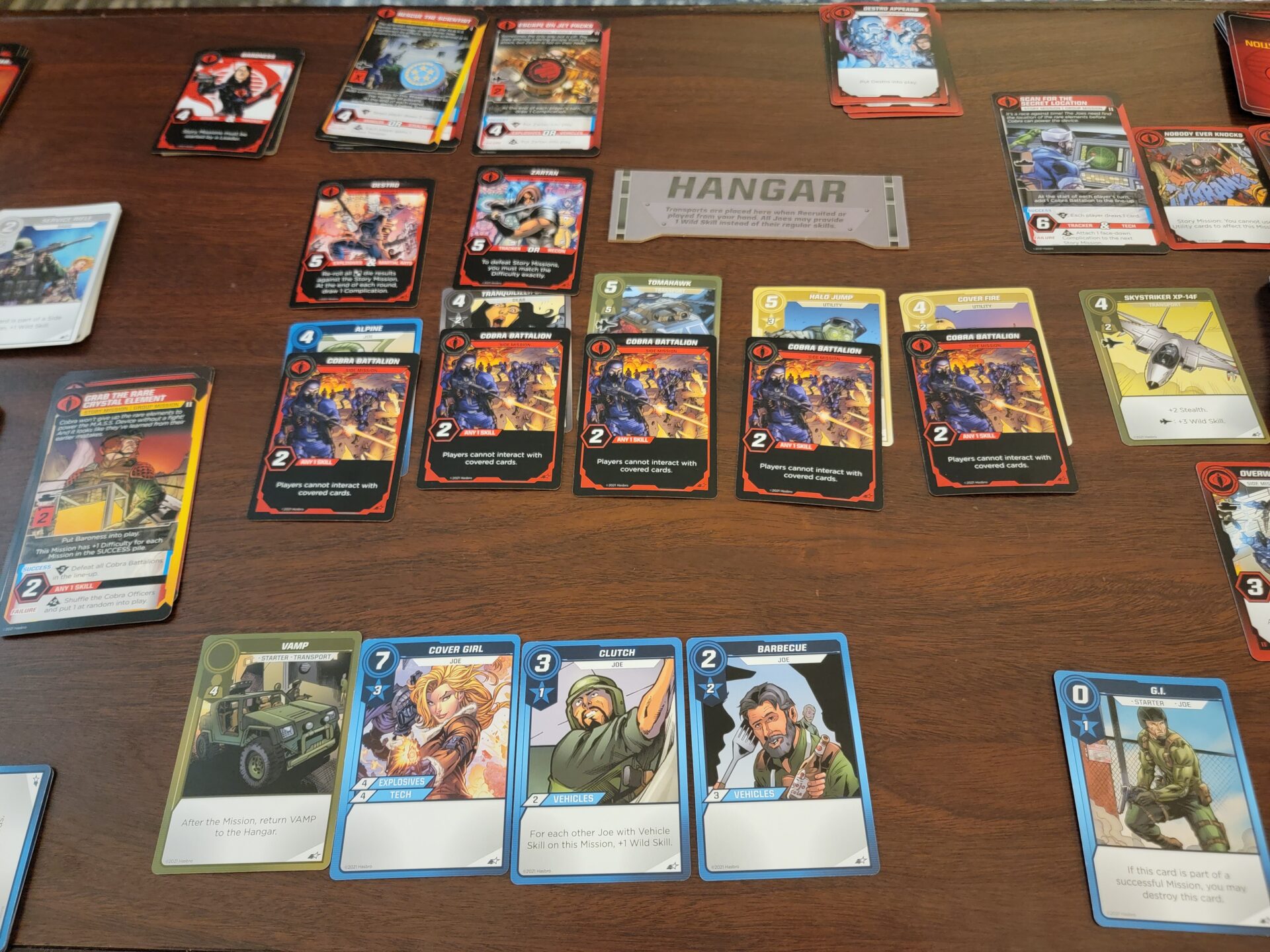
As you’d expect in a deck-building game, setup is mostly shuffling and dealing. You do have to put together the Mission Deck as explained above, but this takes only a few minutes. Once this is completed, each player is given one of the six Starter Leader cards. This can be done in a random order, or players can agree to choose their favorite. Another version of your leader can be found on the Promoted Leader cards, and each player should find theirs in the deck and sit it off to the side. Now, each player will take nine starting cards, made up of six G.I. Recruit cards, one Comms card, one Defuse card, and one Second Effort card. You’ll add your Starter Leader card to these nine cards, shuffling them into your 10-card Starting Deck. Players draw five of these cards to make their Starting Hand.
The rest of the Player Card deck is to be shuffled, placed face down in the middle of the table and then six cards are flipped over to create the Line-Up, a sort of market of cards that players will be able recruit from. On the Cobra side of things, players will need to separate the Complication Cards into their three Act categories. Act I cards are shuffled and put out on the table, face-down, with Acts II and III being placed to the side to be used later. All other Cobra cards are put in individual stacks depending on the type of card they are.
Lastly, the Threat Meter has a Threat Marker placed on the starting position at the bottom of it and the Hangar Tile should be placed in the middle of the table. Near the Hangar, the starting Transport card, the VAMP, should be placed and additionally, the stack of Service Rifle cards should be put out so all players can reach it. Now, the JOES are ready to go on their first mission.
The overall cadence of the game is as follows, though please note that there will be some cards that are drawn that might cause you to veer off this path slightly. Also, you should note that the very first round is slightly different so we will circle back to that in a minute.
Start Phase:
First, if there is no Story Mission card flipped over, one needs to be flipped. These Mission Cards are going to be the main driver behind what decisions the players are making. For right now, just know that one will be active at a time and the card will help players to focus their energies.
The second part of the Start Phase is making sure to trigger any Start of Turn Effects. These will mostly be found printed on cards that are in play. If there are multiple effects to trigger, the JOES get the short end of the stick as you have to resolve Story Mission effects first, then Cobra effects, and then finally any on the JOES cards.
Action Phase:
When taking the Action Phase, it is important that each player fully completes the two steps within the Action Phase, before it goes on to the next player. Even though this is true, non-active players (those who aren’t actively in the Action Phase) can communicate with other players as well as contribute JOES to Story Missions.
The first decision the Active Player needs to make is if they are going to send any of their JOES on a mission. These missions can be either the Story Mission, which the whole group can contribute to, or there might be Side Mission cards present that only the Active Player can send soldiers on. If a Story Mission is declared to be the target of this part of the Action Phase, a Transport in the Hangar needs to be selected.
The Transport cards contain a few parts of vital information that will help in deciding if it is the right mode of transportation for the selected mission. The first thing players will probably want to look at is the Capacity of the transport as this is going to determine how many JOES can actually go on the mission. For example, the Tomahawk transport allows five JOES to deploy, meaning that between the Active Player and all other players, five different JOE cards can be selected for the mission. The Transport card also has a Transport Type, either a tank symbol for Land, an airplane symbol for Air, or a boat symbol for Sea. While any type of transportation can go on any mission, if the Transport Type matches the Terrain Type printed on the mission card, there is typically an advantage that triggers for the players.
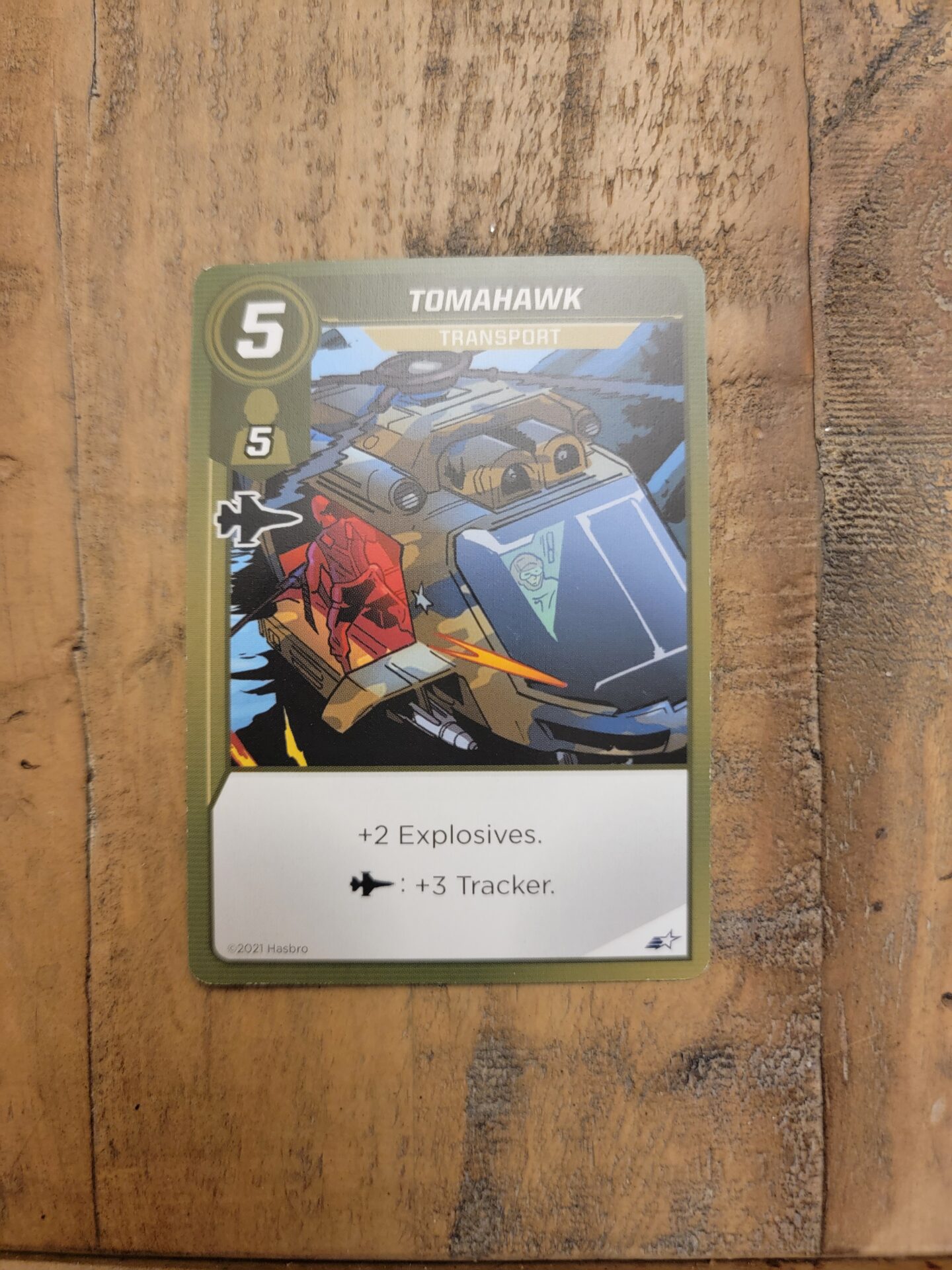
After the Transport card has been selected, and players know how many JOES to deploy, it is time for players to play JOES from their hand to the table. This is when players will want to look at the Mission Card in more detail, as they will be printed with both a Skill Type (possibly multiple ones) and a Difficulty Number. Players will notice that each of their JOES will have at least one Skill Type on their card as well, with a value preceding it. For example, the JOE Leader Rock ‘N Roll has a 4 skill in Recon and a 3 skill in Marksman. If this JOE is selected for a mission that has a Skill Type of Recon, this card’s owner is going to be able to add four dice to the combat pool.
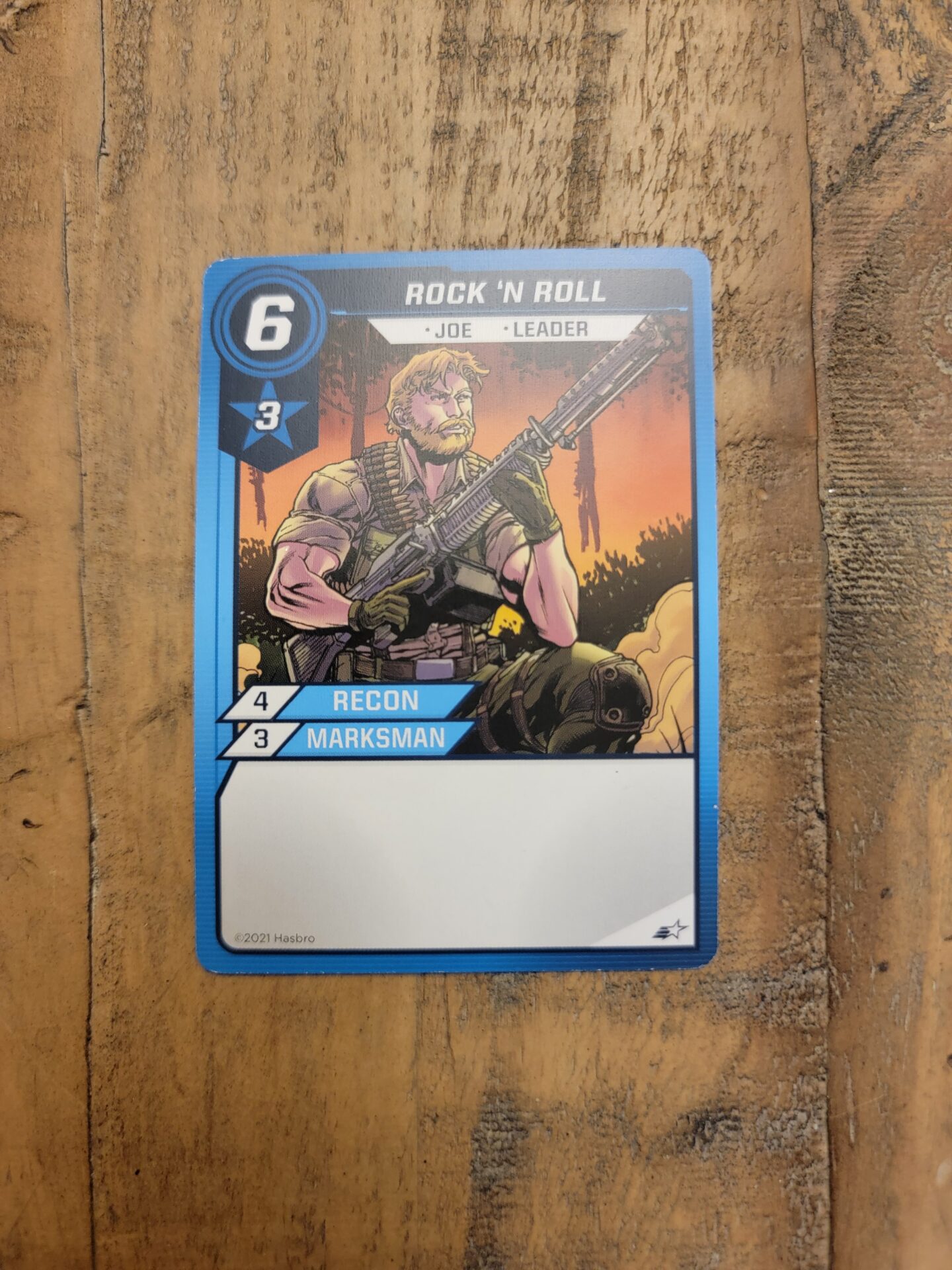
Players are going to want to match up their JOES with the current mission that will allow them to add the most dice to the combat pool. Sometimes, a JOE needs to be played but they don’t match any of the skills listed, in this case they are treated as a Wild Skill and are able to add a single die to the pool. When all cards have been played, the combat pool is created and then the dice are rolled. Players will add up all Hits (represented by targets on the die sides) and if they have an equal or higher amount than the Difficulty Number on the mission, the players are successful.
Any player who contributed a JOE to the mission also needs to look at their hands for any Utility, Gear, or Basic cards that are printed with the Mission Icon. This signifies a card that can be played during a mission that can severely turn the tides for the JOES if they happen to have a string of bad rolls. Players should note that if they did not contribute any JOE cards to the missions, they are not allowed to play any of these auxiliary cards during the mission. Another word of note is that many Story Missions have a certain number of Complication Cards that have to be drawn, and resolved, before players can actually “go on the mission.”
Whether or not the players succeed or fail, they have to resolve the action printed in the appropriate space on the Mission Card. Once resolved, the card is moved to either the Success Pile or the Failure Pile, for possible use later on. All non-active players will now discard the cards they put towards the mission, and they do not draw back to five as the round is not over. This adds an interesting wrinkle to non-active players as they have to weigh playing a JOE towards a mission against having a limited card selection when it is their turn to be the Active Player.
The Active Player keeps his/her played cards on the table as they will not be used in the second part of the Action Phase, called Recruitment. Players will notice a number emblazoned within a star on the top left of each of their cards. This value is considered to be their Recruit Value, and the Active Player should now add up all these values on the cards they’ve played towards the mission thus far this turn. If they wish for a higher value, they can place any other cards from their hand onto the table and add those Recruit Values to their total. The Active Player can now use this value to purchase cards from the Line-Up, the six card market that we set up earlier in the game. The Active Player can buy as many cards as they want, as long as they have enough Recruit Value. All cards recruited are placed face-down on top of the Active Player’s deck, ensuring that they will draw them in the next round. The Line-Up is also refilled back to six cards.
End Phase:
When the Active Player has finished recruiting cards, they move on to the End Phase. At this point, they trigger any Story Mission effects, Cobra effects, and Side Mission effects that specifically say to be triggered at the end of a player’s turn. Afterwards, the player will discard anything in their hand they didn’t use as well as all cards they played and then re-draw their hand back to five cards. Now the next player becomes the Active Player.
All players will take turns being the Active Player and work through these three phases. Once all have taken a turn, the End of Round is triggered. Again, players check Mission and Cobra cards for any effects that might be triggered at the end of the round and resolve them. The Threat Meter must also be raised one level, typically complicating the JOES life as the game lasts longer. If the team can successfully work through the full mission without having the Threat Meter reach the last space, or failing a mission card that immediately ends the game, the players win and bring home a victory for the good guys!
General Thoughts
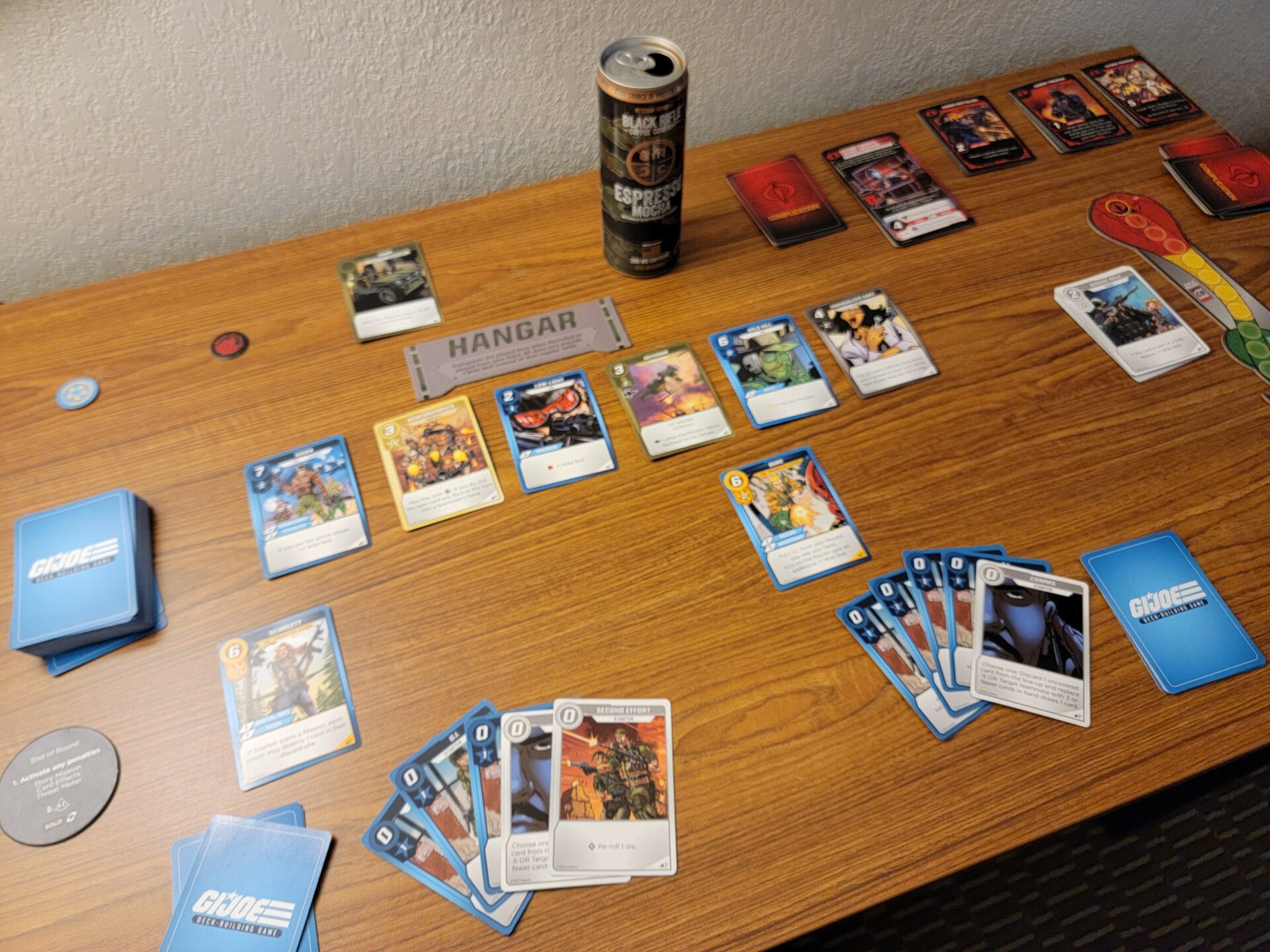
There are a lot of things about this game that I enjoy but I’ll call out two. First, the whole way the game handles allowing all players to participate in the Story Missions is just really fun. This aspect of the game inspires true collaboration between the players and enhances the feeling of “teamwork” throughout the game. It’s a cool touch that only players who contribute a JOE can play auxiliary cards for the mission. Knowing that this might weaken their own turn but being able to benefit the greater good is a nice decision point to make.
Second, the building of the Story Mission is a great way to keep the game varied enough without blindsiding the players every time they play. I do wish that there was at least two or three different Act 1 Finale Cards though. In my experience, we typically make it through Act 1, so we end up seeing that same Finale Card over and over again. Having a few Act 1 Finales would increase the variety even more and definitely wouldn’t hurt in any way.
On the negative side of things, the game can be rather ruthless, especially with the Side Missions and the Complications Deck. The Side Missions can really hurt as only one player can go on them and if the player doesn’t have the right skills, then they are seriously hampered. A lot of times if these cards aren’t defeated within a turn (or a round) they can really start hammering players by making them increase the Threat Meter or covering cards up on the Line-Up. Even more difficult is the Complication Cards that have to be resolved before a mission can officially start. Sometimes players have played the perfect cards for a mission, using the best transport available, and then the Complication Cards come out and wreck the whole thing. Maybe in playtesting, it was found that the missions were too easy and they added these for difficulty, but more often than not in my plays, these cards just make me mad and don’t really add any engaging challenge to the game.
Solo Mode Thoughts
Lastly, the game comes packaged with a way that someone can play this game solo but in my opinion, it’s pretty much trash. It adds some confusing tidbits to how many turns the player can take before a round ends, and really just messes with the flow of the whole game. It also completely eliminates the feeling of helping the team out. I strongly recommend that if you want to play solo, you just deal out as if you’re playing a 2-player (or even 3-player) game and just play each hand. When I’ve played in this manner, I’ve really had fun with this game so my “solo rating” below will be based on this, instead of the official mode printed in the rulebook.
Conclusion
I didn’t really know what to expect when purchasing G.I. JOE Deck-Building Game, but I have to say that I was pleasantly surprised. Outside of Arkham Horror, I don’t have any cooperative card games, so it was nice to have something to continue to round out the collection. While the game can be tough (especially when dealing with unlucky dice rolls), its strengths unveil themselves when players are able to band together to create the perfect combination of JOES to bring down the Cobra baddies.
Rating
Ratings are based on 5 main criteria: rulebook, setup, components, art & graphic design, and gameplay. The first 4 criteria are rated 1 to 5 and the gameplay is rated 1 to 10. These scores culminate in an “overall satisfaction” score that is rated from 1 to 10. If the reviewed game has both a solo and multiplayer mode, I have assigned scores separately to give context to which mode we enjoy more.
Links
As an Amazon Associate I earn from qualifying purchases.
